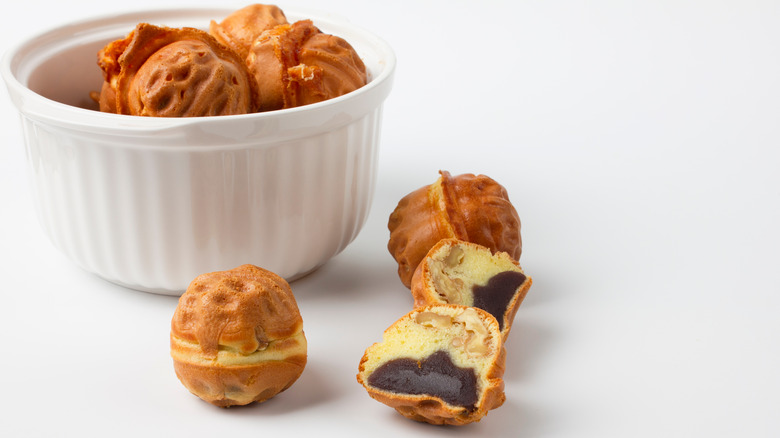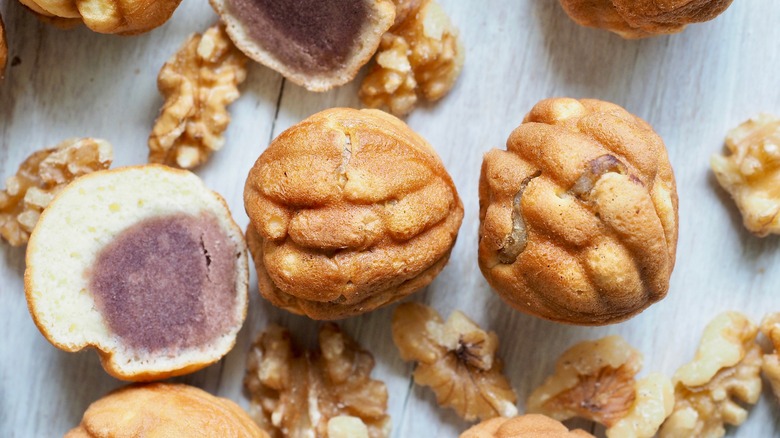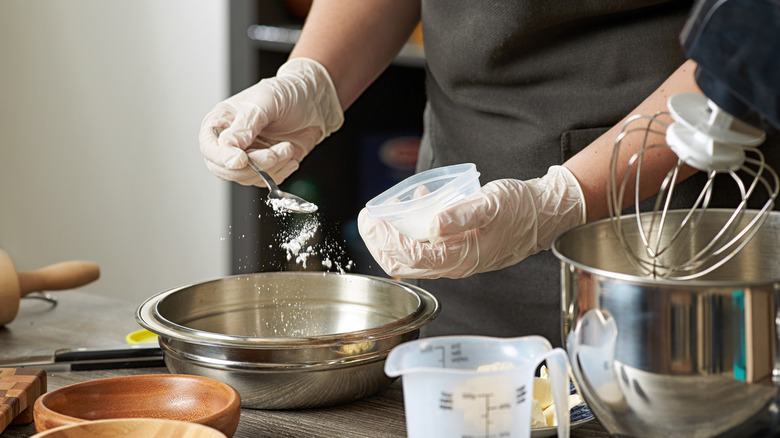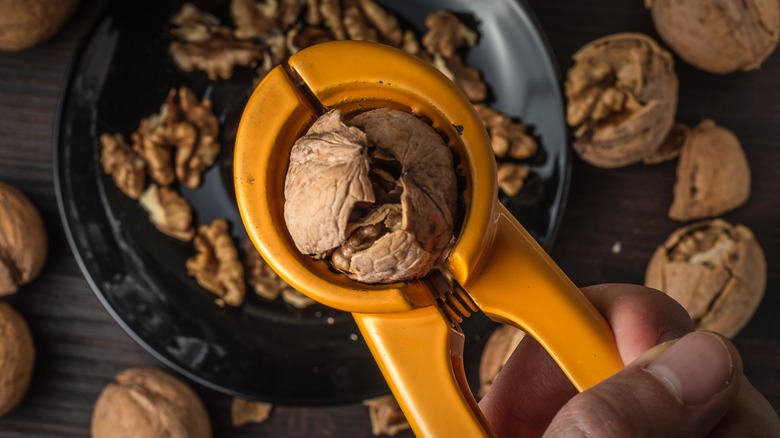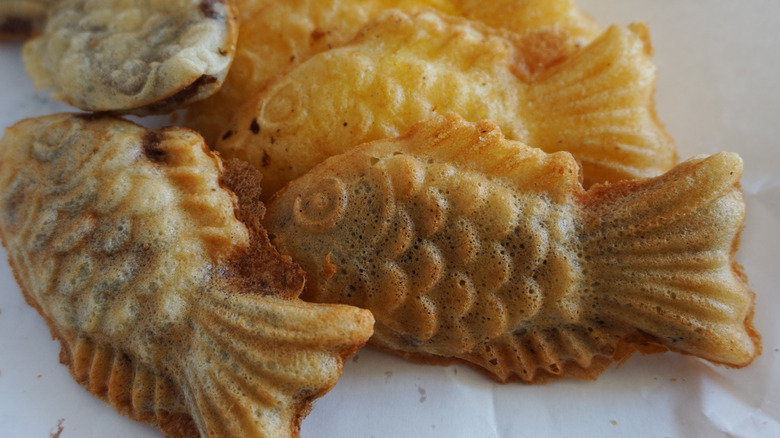Hodu-Gwaja: The Delightful Walnut Cookies From South Korea
Walking through the city streets in South Korea is a feast for the senses, thanks in large part to the vibrant street food culture. From tteokbokki (rice cakes in spicy sauce) to soondae (blood sausage) and hot dogs with potatoes on sticks, the smells of food fill the air as people walk to the subway, shops, and bars. One of the best ways to experience Korea is to eat at the food stalls with the locals, advises Lonely Planet.
While much of Korean street food is savory, there are some sweet treats such as hodu-gwaja, a pastry with a sweet and nutty filling. Like roasted chestnuts in New York City, hodu-gwaja tends to be eaten more on chilly winter days in South Korea, per Taste Atlas. It's also a travel snack, according to My Korean Kitchen, which says hodu-gwaja is sold not only by street vendors but also at highway rest stops in the Asian country.
What is hodu-gwaja?
The little sweet treat hodu-gwaja is made from a thin batter and filled with walnuts and sweetened red bean paste cooked in a special pan, according to Taste Atlas. However, My Korean Kitchen adds that mung bean paste may also be used in the filling. Found throughout Korea, China, and Japan, red bean paste is made from adzuki beans that have been cooked, according to MasterClass. Pieces of walnuts are also placed in the center of the pastry, along with the red bean paste, per My Korean Kitchen.
Described as a cookie by Taste Atlas, hodu-gwaja is made of a baked pastry that is often shaped like a walnut shell. My Korean Kitchen refers to hodu-gwaja as a walnut-shaped pastry but comments that others consider it more like a cake or cookie. While most recipes call for plain flour or all-purpose flour for hodu-gwaja, My Korean Kitchen says using cake flour gives the hodu-gwaja a crispy exterior while the inside remains soft. A combination of all-purpose flour and rice flour is used for the walnut pastries by Eater, which says the mixed flour creates a springier and moister treat.
How do you make hodu-gwaja?
Traditionally, a specific mold is used, hodu-gwaja, that gives it its cute whole walnut appearance, but some home cooks prefer not to have to buy a specialty mold for an occasional treat. Eater makes hodu-gwaja using a muffin tin, although the overall composition ends up looking different. Sift and Simmer adds a different twist to hodu-gwaja by creating a waffle inspired by the pastries.
To make a traditional hodu-gwaja, put the batter of flour, baking powder, sea salt, water or milk, raw castor sugar, melted butter, and an egg into a pitcher and pour it into your mold, advises My Korean Kitchen. After you put the walnut cake mold on top of the stove (the burner should be at low heat), it needs to be brushed with melted butter to prevent sticking. Then, the mold is ready for the batter. Pour 60% of it into the mold. Next, spoon the red bean paste onto the mold and add pieces of walnut before covering with additional batter. After the mold is filled, My Korean Kitchen says to cook it closed on medium heat for four minutes on each side or until the walnut pastry is golden brown. Once the hodu-gwaja is done cooking, remove it from the pan and let the pieces cool.
The best time to eat the hodu-gwaja is while they are fresh, so they have a crispy exterior, per My Korean Kitchen.
What is the history of hodu-gwaja?
Walnuts (hodu) have long been enjoyed on the Korean peninsula, per KoreabyMe, which reports that only royalty was allowed to eat them at one point. The nuts weren't aren't native to Korea but were brought to the region by Arab and Chinese traders. Walnuts continued to play an important role in Korean culture, with the nuts being eaten on "daeboreum," which is the first full moon, per The Korea Times. Eating the nuts on this day was believed to prevent disease. Also, it is said in Korea if a walnut shell is cracked and the nut is whole, it's a sign of good luck. Walnuts have always remained an expensive item in Korea, but using them as a filling has made them more economical.
Hodu-gwaja is a 20th-century creation that originated in the city of Cheonan, which is about 53 miles south of Seoul. The treat was created by a couple, Jo Gwigeum and Sim Boksun, in 1934. They were influenced by Japanese baking and sold their special walnut cookies in the family's bakery in Cheonan, reports The Korea Times. The treat largely remained unknown outside of Cheonan until the 1970s, when it began to spread around the country.
Variations and similar treats
As the popularity of hodu-gwaja has grown, so have the varieties of fillings. Some alternative fillings include cream cheese or custard cream, which KoreabyMe says pairs well with coffee. My Korean Kitchen says Nutella has also become a common filling in hodu-gwaja.
With its bean filling and pastry-like exterior, hodu-gwaja is similar to two other street food treats: bunggeoppang and gukhwa-ppang. Also known as Korean fish-shaped pastry or Korean carp bread, bunggeoppang is made of a dough with a sweetened red bean paste filling and baked in the shape of a fish, per Asian Food Network. What differentiates it from hodu-gwaja is that it does not contain walnuts. Also similar to hodu-gwaja is gukhwa-ppang, or chrysanthemum bread. It is also made from dough baked in a chrysanthemum-shaped mold and filled with red bean paste, per Chef's Pencil. Traditionally, only red bean paste was used as a filling, but more ingredients are now being used, including honey, peanuts, and walnuts.
Whether you eat your hodu-gwaja with the traditional red bean filling or sweeten it with Nutella, let this delicious Korean treat warm you on a chilly day.
